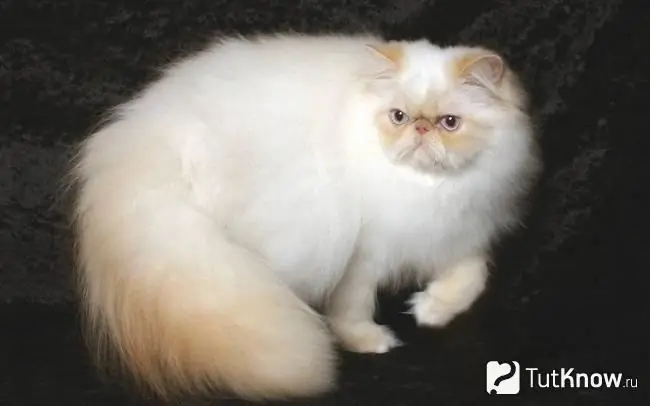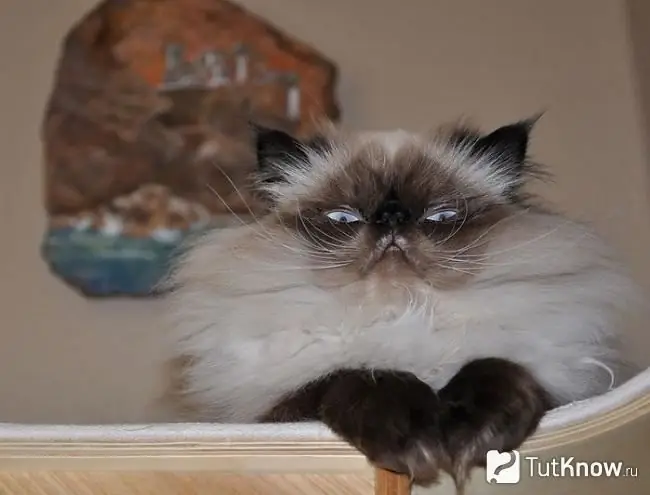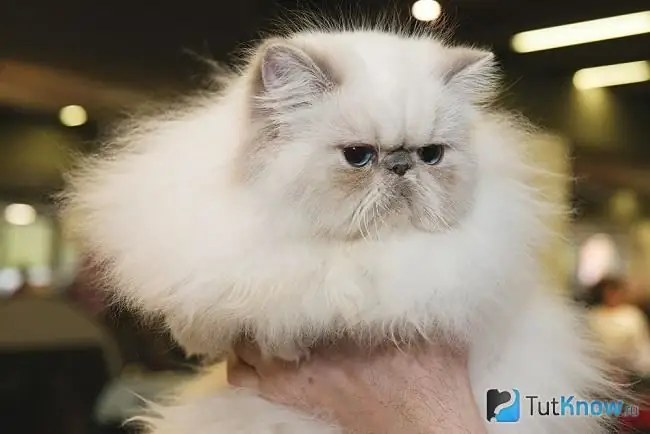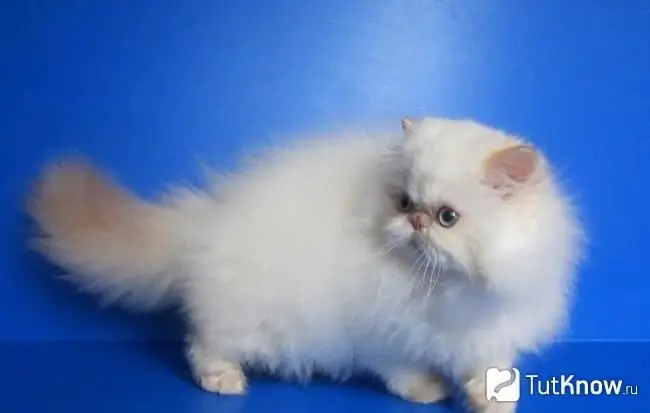The history of the breed, the standard of appearance of the Himalayan cat, character traits, health and possible difficulties, advice on the care and maintenance of a pet at home, the price of a kitten. Himalayan cat (Himalayan cat) - if someone does not know her, then you should at least look at the photo with the image of the animal and you will not be able to forget it. According to external data, these cats resemble a cute, voluminous and very fluffy cloud, which, while living in your house, will not only give you joy, but will become an integral decoration of your home. By nature, these representatives of the feline world also got a very enviable character, they are friendly, open, calm and at the same time cheerful and perky. In general, there is certainly nothing to find fault with individuals of this type of cats.
History of the origin of Himalayan cats

These extremely fluffy cats appeared on our large planet not so long ago. The first official mention of the pretty Himalayan cat with an extraordinary fur coat dates back to around the mid-30s of the last century. Hearing for the first time the name of the breed, every person somewhere in the subconscious forms the idea that the history of these animals originates somewhere approximately from the foot of Everest. But this is not at all the case, these purrs have nothing in common with the mountains, moreover, they honor Great Britain with their native lands, which cannot "boast" of being close to the Himalayas.
It was there, the professional felinologists Virginia Cobb and Clyde Keller had a very interesting idea in their heads, they decided to try to breed a new breed of cats. Their future creations were to be something in between the Persians and the Siamese. So the future kittens "according to the sketch" should have had a gorgeous coat, like Persian pets, and from the Siamese by inheritance, they were intended to have an original color and beautiful blue eyes.
In the first experimental cross, a Persian with a black coat and a Siamese cat took part, but, as they say, "the first pancake is lumpy," and the newborn kittens were all as one with a short "fur coat" and a rich black color. Then the breeders made not very comforting conclusions for their future activities - the gene that is responsible for both long hair and the Siamese color-point color is recessive.
As it turned out later, such an idea arose not only among the British, but also among the Americans, at the end of the 40s, the American cat breeder Margarita Gofort still managed to achieve the desired result. As soon as the first babies of the new breed appeared in the USA (the progenitors of the Himalayan cat), in England, too, everything went like clockwork. But neither in Britain nor in America the species was in no hurry to register or show it at the exhibition. And this inaction continued for more than one year.
Only after almost a quarter of a century, the members of the commission of the Cat Fanciers Association could not resist these cute fluffy and as a result recognized the breed, but only as a kind of Persian cat. But there were also such felinologists who categorically disagreed with this decision, and soon it was decided to create a new felinological organization that recognized Himalayan cats as individuals.
But, in spite of all the disagreements, a small number of documents that confirm the pedigree of Himalayan cats and their prestige, animals have won the hearts of a large number of people and today are one of the most demanded and by no means cheap pets.
Description of the official standard of appearance and photo of Himalayan cat

- Torso Himalayan cats are nothing more than an optical illusion. Due to the volume and fluffiness of their fur coats, they seem simply huge, but this is not at all the case, as soon as the animal is dipped in water, not a trace remains of the former forms. Their bodies are average in size, the body weight range of an adult cat ranges from 5 to 8 kg, females are much smaller, their weight rarely exceeds 5 kg. These pussies have a very toned body with well-developed muscle tissue. As for the physique, these pets are squat, with a voluminous slightly lowered chest, a large rounded abdomen and a short neck, scientists call this type of body a cobby.
- Limbs Himalayan cat is shorter than average in length, they can even be called short, but very wide, strong and stable. They end in llama pads, rounded in shape, which are rather large in size.
- Tail process very smooth, without a single break or flaw. The length harmoniously corresponds to the length of the cat's body. The tail of these cats is very beautiful because of the hair on it, it is very, very long, thick and extremely soft.
- Head in size it can be either medium or rather large, the main thing is that its parameters are in harmony with the dimensions of the animal's body. Rounded in configuration, with smooth, smooth outlines. The jaws of the animal are wide and strong, the bite is necessarily correct. The chin is powerful, but at the same time looks very beautiful in the company of full, well-visualized cheeks. The face of the Himalayan cat is especially attractive - it is wide, short, and even flattened, which gives its appearance a special charm and sweetness.
- Eyes Himalayan cats are huge, round in configuration. They are located at a great distance from each other, they are slightly convex. As for the color of the iris of the eyes, according to the breed standard, a riot of colors is allowed within the blue range.
- Auricles these pets are small in size, with slightly rounded tips, placed widely.
- Nose among purebred Himalayans, it should be the same in size, both in width and length. Well open nostrils. In profile, the olfactory organ should be in a straight line with the chin and forehead.
- Wool Himalayan cat is their main attraction. It is very long and very voluminous due to the presence of the thickest additional undercoat. The texture of the animal's coat is very delicate and soft. The standard requires the presence of a longer coat around the neck, which forms a "collar".
- Color Himalayan cat can only be in color-point variation and nothing else. Representatives of this breed have some peculiarities of color; there should be a noticeable contrast between the main tone of the color and the color of the points. Points are a darker color scheme on certain areas of the animal's body. So the Himalayans have their ears, paws, muzzle and tail decorated with points. It is the tone of the points that indicates the type of color of the cat. The breed standard allows the following color options: blue point (blue), lilac, dark brown, chocolate, red and beige.
Character features of Himalayan cats

As for the set of qualities of temperament, the representatives of this breed, without a grain of doubt, can be called the cutest living creatures that never rush anywhere. These charming Murziks have an extremely measured and balanced way of life, which sometimes it seems that they bring a certain peace of mind into a person's life. Such a pet will not rush around the house, headlong, he always walks solidly through the rooms, accompanying his master and watching when he lies down. As soon as the cat notices this, immediately, without wasting a minute, he will settle down beside him. It cannot be said about Himalayan cats that they always need a lot of your attention, they have a great time alone, and when they want to play, or to be scratched behind the ear, the animal itself will notify about this in a quiet, calm voice.
But, despite all this mannerism and phlegm, these live "clouds" also know how to be playful and perky, if the cat is interested in an interesting game, he can tirelessly drive and frolic, due to which, most often, it is little children that become the best friends of Himalayan cat. And what a delight it is to watch from the sidelines a charming ball of amazing fur rushing down the corridor.
When bringing such a pet into the house, one important nuance should be taken into account, Himalayan cats hate a limited and confined space, or, more correctly, a locked door. The pet needs to feel like a full member of the family, if, when you go to bed, you close the door behind you, be prepared that the animal, upon hearing this, will immediately start asking for you. The Himalayan needs to know that he has the right to be anywhere, anytime. For this reason, it is better not to spend money on beautiful and cozy cat houses, he will definitely not live there, lie down for a few minutes - yes, but the place to sleep will most likely be in the master's bedroom. Himalayan cats are very partial to the sun's rays. So, if you just can't find your tailed friend in sunny weather, you can be sure - he is on the windowsill, basking in the sun.
Himalayan cat is always happy to be friends with other pets if they are in a positive mood. They get along well with both dogs and cats, the situation is somewhat different with birds, rodents and fish. Whatever cat is calm and balanced, but the feline principle in him still has a desire to hunt in his blood. So sooner or later, he can attack a small animal.
Nature has awarded the Himalayans not only with an amazing appearance, but also with remarkable intelligence. From the first days of living in the house, this animal gets used to all its inhabitants, the daily routine and to the elementary rules of behavior. Also, there are rarely oversights in teaching a cat to relieve himself in a tray and grind his claws on a scratching post. In the case of the tray, it is worth remembering that this Himalayan cat will never use his lavatory, if he is a mile away from her, he is very clean and squeamish.
Himalayan cat health

These pets can be called quite healthy and strong animals, which, by nature, have got a very good immunity. However, do not forget about heredity, which is not always pleasing. So, at the genetic level, the representatives of this species inherited a predisposition to certain diseases from Persian cats.
Polycystic kidney disease is a fairly common and extremely serious kidney disease that sooner or later can lead to acute and chronic renal failure. Unfortunately, all processes in the affected organ are irreversible, and it is very difficult to diagnose the disease in the early stages. Rarely do cats show any symptoms, most often the problem makes itself felt by frequent urination, lack of appetite, weight loss, the presence of blood in the urine, depressive behavior of the Himalayan cat. The abdominal cavity can noticeably increase in volume, with a clearly reduced body weight. Therefore, it is imperative that the Himalayan cat be shown to the veterinarian on a regular basis, even if there are no such alarms. Thorough examinations, general analyzes and some instrumental research methods can contribute to the early diagnosis of the disease and although it cannot be eradicated, it is still quite possible to stop the development and improve the quality of life of the pet and its duration.
Hypertrophic cardiomyopathy is a problem that is not so common among Himalayan cats, but it should be kept in mind as they have a tendency. This pathology entails thickening and deformation of the walls of the heart, which, without adequate treatment, can lead to fatal consequences. It is quite possible to diagnose this problem in the early stages, but for this you need to regularly visit a medical institution and conduct an ECG and echocardiography for your pet, at least once every six months. The first symptoms of hypertrophic cardiomyopathy are cardiac arrhythmias, palpitations that are rapid and audible at a distance, sudden, short-term loss of consciousness. But do not forget that sometimes the first sign of this pathological condition is sudden death against the background of imaginary well-being, so it is so important not to neglect regular research in order to protect your friend.
The teeth and soft tissues of the oral cavity are the "Achilles' heel" of the Himalayans; if not properly cared for, tartar forms and inflammation of the gums occurs in record time. Therefore, dental hygiene is first of all, otherwise the life of the animal will be greatly spoiled.
The skin of Himalayan cat is also very sensitive, because of the voluminous coat, the sebaceous glands work hard, so they have various dermatitis irritations, but good shampoo and frequent bathing can easily cope with this problem.
Care and maintenance of a Himalayan cat at home

- Hair care. This is not to say that it will be easy with such a chic fur coat, but there is nothing difficult in caring for it. Daily brushing is vital for these fluffy pets, if you have the opportunity to do this procedure twice a day - it will not be superfluous. You need to comb them, both for an aesthetic purpose, so that your friend always looks his best, and in order to prevent clogging of the gastrointestinal tract with wool. By neglecting the daily brushing of your coat, you risk the health of your Himalayan. Since he has a huge amount of hair, a hairball in his stomach forms in record time. In this regard, it is recommended to provide your pet with plants that contribute to the elimination of hair, it is also good to feed the cat with special vitamins from time to time. As for bathing, Himalayan cat needs to be bathed often, but it should be borne in mind that they love water very much and are ready to wash at least every day. The main thing is to choose the right shampoo. When choosing a detergent, it is best to give preference to a shampoo for combination skin, it is very important that the product is of high quality, without unnecessary impurities, for example, fragrances and dyes. Since the delicate skin of your pet will immediately react to all unwanted ingredients, allergies, or other skin problems.
- Hygiene. Due to the anatomical structure of the face of Himalayan cats, their lacrimal canals work much weaker, so they need to wipe their eyes every day, you can just use a piece of cloth soaked in water at room temperature, or you can use decoctions of herbs or infusion of black tea. Himalayan teeth need to be brushed, the more often the better, but several times a week is recommended. The cat needs to be taught to this procedure from early childhood, so it will be easier for him to get used to such an unpleasant process. Ears need to be cleaned of sulfur deposits, dust particles and dead epidermis about once a week.
- What to feed? Experts unanimously recommend feeding Himalayan seals with ready-made food of high quality, you can combine dry and wet. It is important to know that these living "clouds" are very fond of eating and therefore are prone to obesity, therefore they need to be fed often, but in fractional portions.
Himalayan cat: price of a kitten

The initial cost of a purebred Himalayan cat kitten with a package of documents starts at 10,000 rubles, but prices may vary depending on many factors. So a baby without documents will cost about 5,000-7,000 rubles, and a show-class kitten can be estimated at 20,000 or 30,000 rubles.






